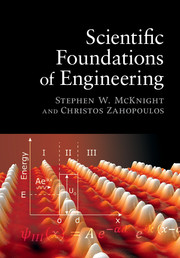Book contents
- Frontmatter
- Contents
- Introduction
- 1 Kinematics and vectors
- 2 Newton's Laws, energy, and momentum
- 3 Rotational motion
- 4 Rotation matrices
- 5 Materials properties: elasticity
- 6 Harmonic oscillation
- 7 Waves
- 8 The quantum puzzle
- 9 Quantum mechanics
- 10 Quantum electrons in atoms, molecules, and materials
- 11 Quantum electrons in solids
- 12 Thermal physics: energy, heat, and thermodynamics
- 13 Quantum statistics
- 14 Maxwell's equations and electromagnetism
- 15 Electromagnetic waves
- 16 Electromagnetic materials
- 17 Fluids
- Bibliography
- Index
13 - Quantum statistics
Published online by Cambridge University Press: 05 September 2015
- Frontmatter
- Contents
- Introduction
- 1 Kinematics and vectors
- 2 Newton's Laws, energy, and momentum
- 3 Rotational motion
- 4 Rotation matrices
- 5 Materials properties: elasticity
- 6 Harmonic oscillation
- 7 Waves
- 8 The quantum puzzle
- 9 Quantum mechanics
- 10 Quantum electrons in atoms, molecules, and materials
- 11 Quantum electrons in solids
- 12 Thermal physics: energy, heat, and thermodynamics
- 13 Quantum statistics
- 14 Maxwell's equations and electromagnetism
- 15 Electromagnetic waves
- 16 Electromagnetic materials
- 17 Fluids
- Bibliography
- Index
Summary
As a young professor of electrical engineering, the first author returned for a visit to the institution where he had received his PhD in Physics. His former thesis advisor, a professor of physics, was on his way to be part of a PhD oral qualifying exam committee for students in their second year of graduate study in physics. “What should I ask this guy [the qualifying exam student]?” he asked. “Why don't you ask him how a p-n junction diode works?” your first author, who had just taught a course in physical electronics, suggested. His former advisor stopped in mid-stride and said “What, do you want him to faint dead away?”
It is our suspicion that not only physics graduate students but most engineers (including electrical engineers!) would have the same difficulty in describing the operation of a p-n junction, the most fundamental and ubiquitous device in all semiconductor electronics. So how does a p-n junction, the basis of virtually every electronic device that we use every day, work? And what does that have to do with the red-hot color of a burner on an electric stove or the radiation from the Sun? These are some of the questions we will address in this chapter where we look at statistical applications of quantum theory.
As we have seen in the last chapter, many of the fundamental results of thermal phenomena can be derived by physical arguments applied to the random behavior of molecules in a system in thermal equilibrium at a temperature T. The application of statistical methods to microscopic models of a system to derive thermal phenomena is known as statistical mechanics. In this chapter we will consider the quantum modifications of statistical mechanics and the implications for thermal effects.
To review, three of the fundamental results of quantum theory are listed below.
- Type
- Chapter
- Information
- Scientific Foundations of Engineering , pp. 255 - 281Publisher: Cambridge University PressPrint publication year: 2015



